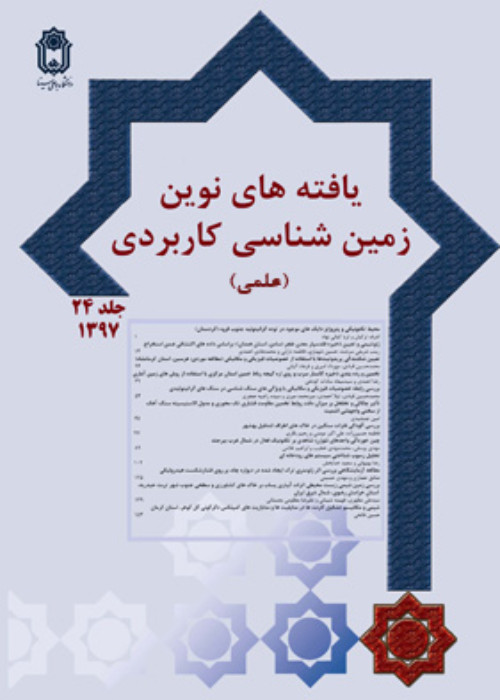Evaluation of physical and chemical characteristics of bituminous deposits in Lorestan sedimentary basin
Author(s):
Article Type:
Research/Original Article (دارای رتبه معتبر)
Abstract:
Bitumen is a mixture of oxidized hydrocarbons with color, hardness, specific gravity and various metamaterials that are in solid or semi-solid forms and can be dissolved in Carbon disulfide (CS2). To evaluate the physical and chemical characteristics of bituminous deposits in Lorestan sedimentary basin (a part of the Folded Zagros zone), 6 fresh and non-weathered bitumen samples were collected from the veins and inside the mines of three areas with high potential of bitumen, including the northern region of Kohdasht, western Poldokhtar and southeastern Sepiddasht. The surface studies of above mentioned area, indicates the appearance of bitumen (tar mats) occurred in Amiran Formation. According to the analysis, the average amount of oxygen, nitrogen and carbon in the studied samples is 6.30%, less than 1% and 74.47% respectively, the average percentage of mineral ash and moisture of the samples is 6.4% and 0.8 percent respectively which indicates the very favorable quality of the studied bitumens .The solubility of studied bitumens in CS2, benzene and ethanol solvents shows that most of these bitumens have compounds with high molecular weight (asphaltene molecules) and low amounts of hydrogen (average 6.02). This example is also consistent with this conclusion. X-ray fluorescence analysis (XRF) on 6 bitumen samples from the studied area shows that Al2O3, SiO2 and Fe2O3 oxides are more abundant than other oxides. This issue can be due to the formation of this mineral in the host rock of the Amiran shale formation, which is rich in the mentioned elements. The values of CaO and K2O in the analyzed bituminous samples can be due to the formation of this mineral from the underlying formations (Ilam and Gurpi) which have found their way into the Amiran formation after formation and migration. The ratio of Ni vs V of the samples of the studied area is low (Ni/V <1) and has an average of 0.57%, so their rock of origin was somewhat carbonate-shale. The current studies reveal that, the origin of the studied bitumen started from deeper and older shale sediments (Ilam and Gurpi Formations), in which the deeper bitumen has migrated upward and washed the younger hydrocarbons to shallower formations and earth surface accumulation.
Keywords:
Language:
Persian
Published:
Journal of New Findings in Applied Geology, Volume:17 Issue: 34, 2024
Pages:
114 to 126
magiran.com/p2704631
دانلود و مطالعه متن این مقاله با یکی از روشهای زیر امکان پذیر است:
اشتراک شخصی
با عضویت و پرداخت آنلاین حق اشتراک یکساله به مبلغ 1,390,000ريال میتوانید 70 عنوان مطلب دانلود کنید!
اشتراک سازمانی
به کتابخانه دانشگاه یا محل کار خود پیشنهاد کنید تا اشتراک سازمانی این پایگاه را برای دسترسی نامحدود همه کاربران به متن مطالب تهیه نمایند!
توجه!
- حق عضویت دریافتی صرف حمایت از نشریات عضو و نگهداری، تکمیل و توسعه مگیران میشود.
- پرداخت حق اشتراک و دانلود مقالات اجازه بازنشر آن در سایر رسانههای چاپی و دیجیتال را به کاربر نمیدهد.
In order to view content subscription is required
Personal subscription
Subscribe magiran.com for 70 € euros via PayPal and download 70 articles during a year.
Organization subscription
Please contact us to subscribe your university or library for unlimited access!


